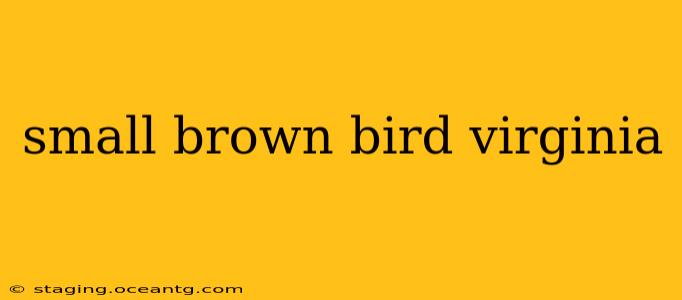Virginia boasts a diverse avian population, and many species share the common characteristic of being small and brown. Identifying these birds can be challenging, but with a keen eye and attention to detail, you can narrow down the possibilities. This guide will help you identify some of the most common small brown birds found in the state, addressing common questions along the way.
What are some common small brown birds in Virginia?
This is a great starting point! Several small brown birds call Virginia home. Some of the most frequently encountered include:
- House Wren: A tiny, energetic bird with a cocked tail and a loud, buzzy song. They are often found near human dwellings.
- Brown Thrasher: Larger than a wren, with a long, curved bill and a distinctive reddish-brown back. Their song is exceptionally complex and varied.
- Eastern Towhee: A relatively large, chunky bird with a black head, a rusty-red back, and a distinctive white outer tail.
- Song Sparrow: A small, streaky bird with a distinctive breast pattern. Their song is a cheerful, melodic chirp.
- Field Sparrow: Similar in size to the Song Sparrow, but more subtly marked, with a pale eyebrow stripe. Their song is a simple, sweet trill.
- Junco (Dark-eyed Junco): Often called "snowbirds," these birds are gray and brown with a distinctive white belly. They're more prevalent in the winter months.
These are just a few examples, and many other smaller brown birds might be present depending on the season and location within Virginia.
What is the smallest brown bird in Virginia?
The title of "smallest brown bird" is difficult to definitively claim without specifying further criteria (e.g., smallest common brown bird, smallest brown bird overall). However, the House Wren is a strong contender for the title of one of the smallest, most common brown birds found in Virginia. Their diminutive size is easily noticeable compared to other brown birds.
How can I identify a small brown bird?
Identifying a small brown bird requires careful observation. Focus on these key features:
- Size and Shape: Is it plump or slender? Long or short tail? Compare it to other birds you know the size of (like a robin or sparrow).
- Color and Markings: Look for subtle variations in shades of brown, the presence of streaks, spots, or other markings. Note the color of the underparts, wings, and tail.
- Behavior: Where is the bird? What is it doing? Is it foraging on the ground, in trees, or in shrubs? Its behavior can offer significant clues.
- Song and Calls: While not always easy to identify by sound alone, bird songs and calls can be very helpful. Consider using a bird identification app with sound recognition capabilities.
- Habitat: What kind of environment is the bird in? Forests, fields, marshes, or near human development? Habitat preference can narrow down the possibilities significantly.
What bird sounds like a cat mewing?
The Brown Thrasher is known for a vocalization that sounds somewhat like a cat mewing, although its repertoire is much more varied than just mewing. Consider this if you're hearing a cat-like sound in a wooded area.
What are some resources for identifying birds in Virginia?
Several resources can assist you in identifying small brown birds in Virginia:
- Field Guides: Comprehensive field guides, such as those published by Sibley or Peterson, are invaluable tools.
- Bird Identification Apps: Numerous apps for smartphones offer image and sound recognition capabilities. Merlin Bird ID (from the Cornell Lab of Ornithology) is a popular and highly effective example.
- Online Resources: Websites dedicated to birdwatching, such as the Audubon Society website (allaboutbirds.org), provide extensive information on bird identification and distribution.
- Local Bird Clubs: Joining a local birdwatching club can provide opportunities for learning from experienced birders and participating in bird walks.
Remember, bird identification takes practice. The more you observe and learn, the better you will become at differentiating between similar-looking species. Happy birding!
